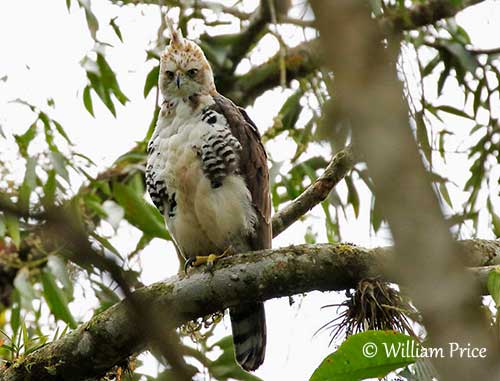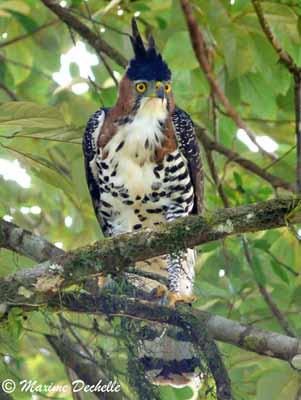
Ornate Hawk Eagle
Spizaetus ornatus
Accipitriforme Order – Accipitridae Family
BIOMETRICS:
Length: 58-64 cm; Wingspan: 90-120 cm; Weight: 960-1600 g
DESCRIPTION:

Ornate Hawk Eagle has black pointed crest and crown. Head, sides of the neck and breast are bright chestnut. Underparts are white, barred with black, but chin, throat and upper breast are white.
Upperparts are blackish or dark brown; feathers have brown base and narrow white tips. Underparts flight feathers are pale grey, barred with four black stripes.
Ornate Hawk Eagle has long and rounded dark brown tail, barred with broad black bands.
Legs are feathered, white streaked with black. Powerful feet are yellow with long talons.
Eyes are orange or yellow. Bill is hooked and black, with pale blue grey lores and yellow cere.
VOICE: SOUNDS BY XENO-CANTO
Ornate Hawk Eagle’s scream is clear and high pitched “whee-oo-whee-oo”. During courtship display, it utters sharp calls, musical notes and rapid laughing series of notes, followed by small crescendos. When it is hunting, it utters a kind of cry like a growl of a cat.
HABITAT:
Ornate Hawk Eagle lives in tropical forests and adjacent open lands, from lowland swamps to up to 8000 to 9000 feet elevation.
RANGE:
Ornate Hawk Eagle lives in Central and South America, from Central Mexico to northern Argentina and Paraguay, but also in Trinidad and Tobago.
BEHAVIOUR:
Ornate Hawk Eagle hunts from a perch, within the forest or at the edge. Prey is taken on ground, snatched from a branch, or taken in flight. This raptor often hunts with stealth and ambush style, moving inconspicuously from perch to perch.
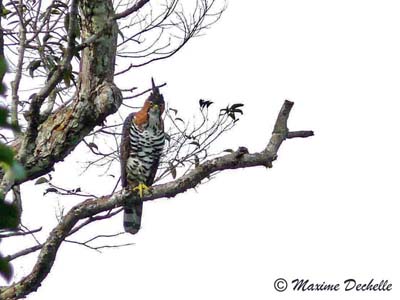
During courtship display, pair glides together, performing flight displays, and then, while female is perched, male performs circles with shallow dives high in the air, alternately diving and rising again, with an angle of 45 degrees, calling the female. It dives down with half folded wings, on a short distance, repeating indefinitely the process. Male may perform looping movements, and sometimes complete loop. At this time, it becomes very noisy, and utters loud calls and musical notes. During these displays, male shows its conspicuous chestnut colour on the sides of the neck. Pair may touch talons in flight, as female turns on her back.
FLIGHT:
Ornate Hawk Eagle often soars in pair. They soar slowly, making circles above forest, at small high. They keep horizontal wings, slightly pointed forehead. Male has an agile and acrobatic flight during courtship display. In flight, we can see its short and rounded wings, and long and broad tail.
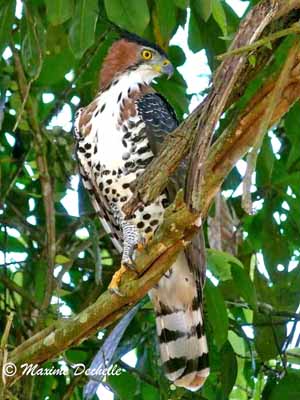
REPRODUCTION:
Ornate Hawk Eagle’s nest is located high in a small tree, generally in a fork. It is very bulky, made with sticks.
Female lays one single egg. Incubation lasts about 44 to 48 days, by female.
While chick is at nest, female feeds it, with food brought by the male, within few hundred feet of the nest. Male gives the food to the female, but it doesn’t feed the chick directly.
When young is able to defend itself, both parents hunt for it.
When the young has fledged, 10 to 13 weeks after hatching, male appears to provide for the young bird. It will be fed by both parents for up to one year after fledging.
This species probably breeds only every third years.
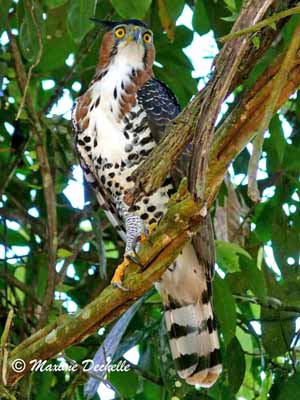
DIET:
Ornate Hawk Eagle feeds on small mammals such as squirrels, medium-sized birds such as Little blue Heron, chickens, parrots, and sometimes reptiles.
PROTECTION / THREATS / STATUS:
Ornate Hawk Eagle is fairly common and not globally threatened, and seldom displayed in zoos.
Fr: Aigle orné
All : Prachtadler
Esp : Aguila de penacho
Italien: Spizaeto ornato
Photographers:
Maxime Dechelle
LEPAPARRAZO
William Price
PBase-tereksandpiper & Flickr William Price
Text by Nicole Bouglouan
Sources :
HANDBOOK OF THE BIRDS OF THE WORLD Vol 2 by Josep del Hoyo-Andrew Elliot-Jordi Sargatal - Lynx Edicions - ISBN: 8487334156
A GUIDE TO THE BIRDS OF COLOMBIA by Steven L. Hilty and William L. Brown
Princeton University Press – ISBN 069108372X
A GUIDE TO THE BIRDS OF MEXICO AND NORTHERN CENTRAL AMERICA by Steve N. G. Howell, Sophie Webb - Oxford University Press - ISBN: 0198540124
Wikipedia (Wikipedia, The Free Encyclopedia)
The Hawk Conservancy Trust (Hilary Smith)
